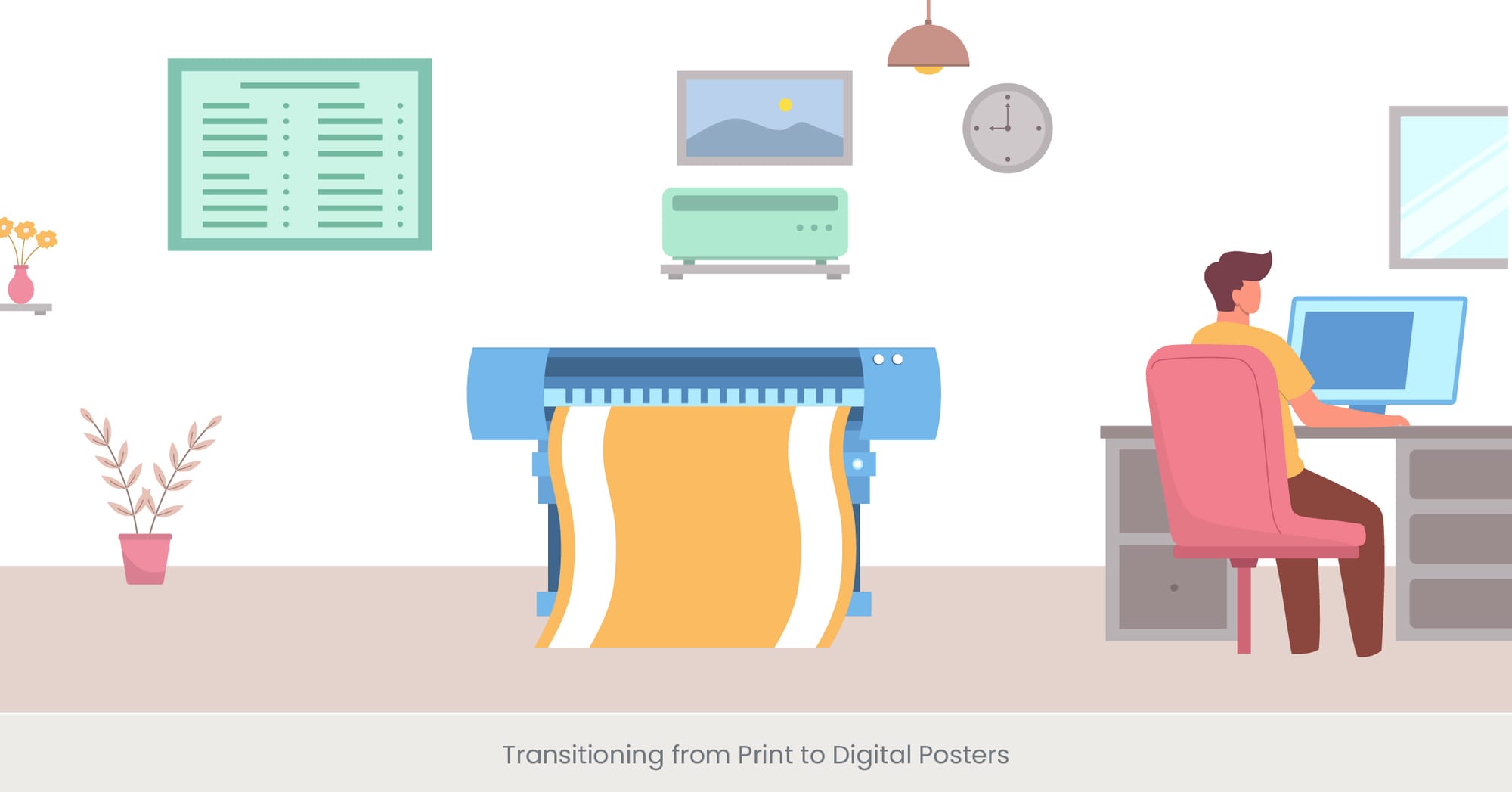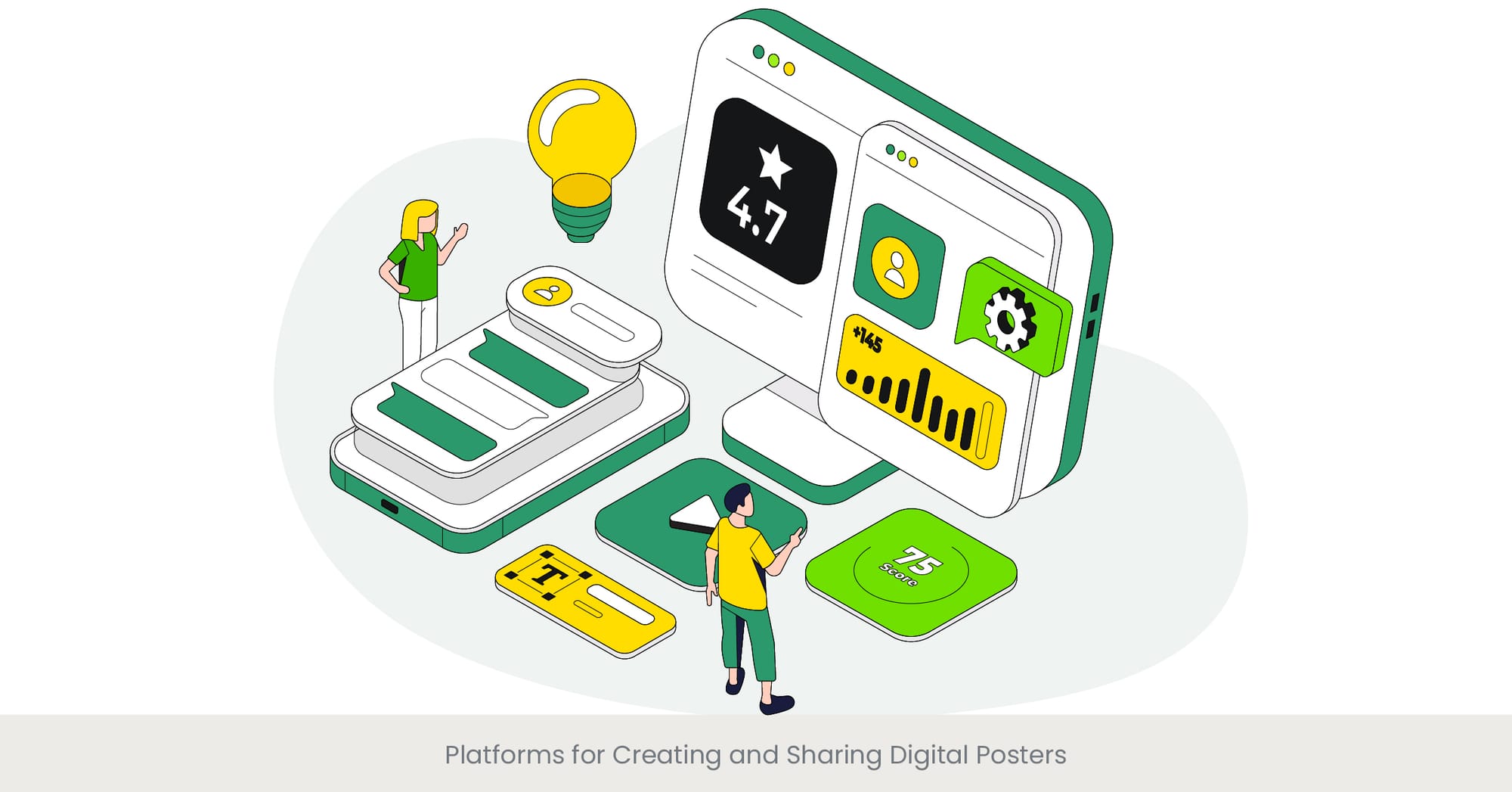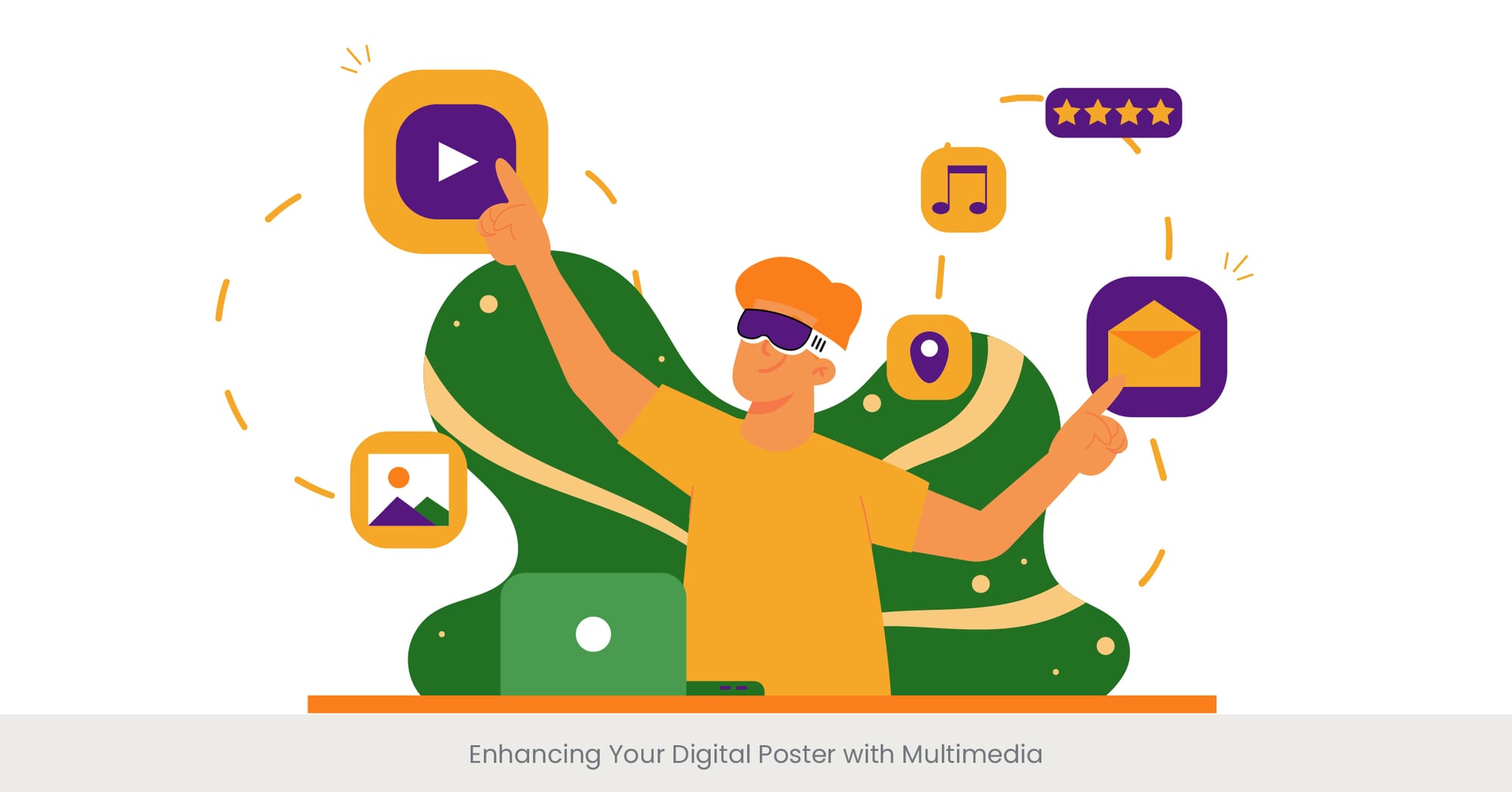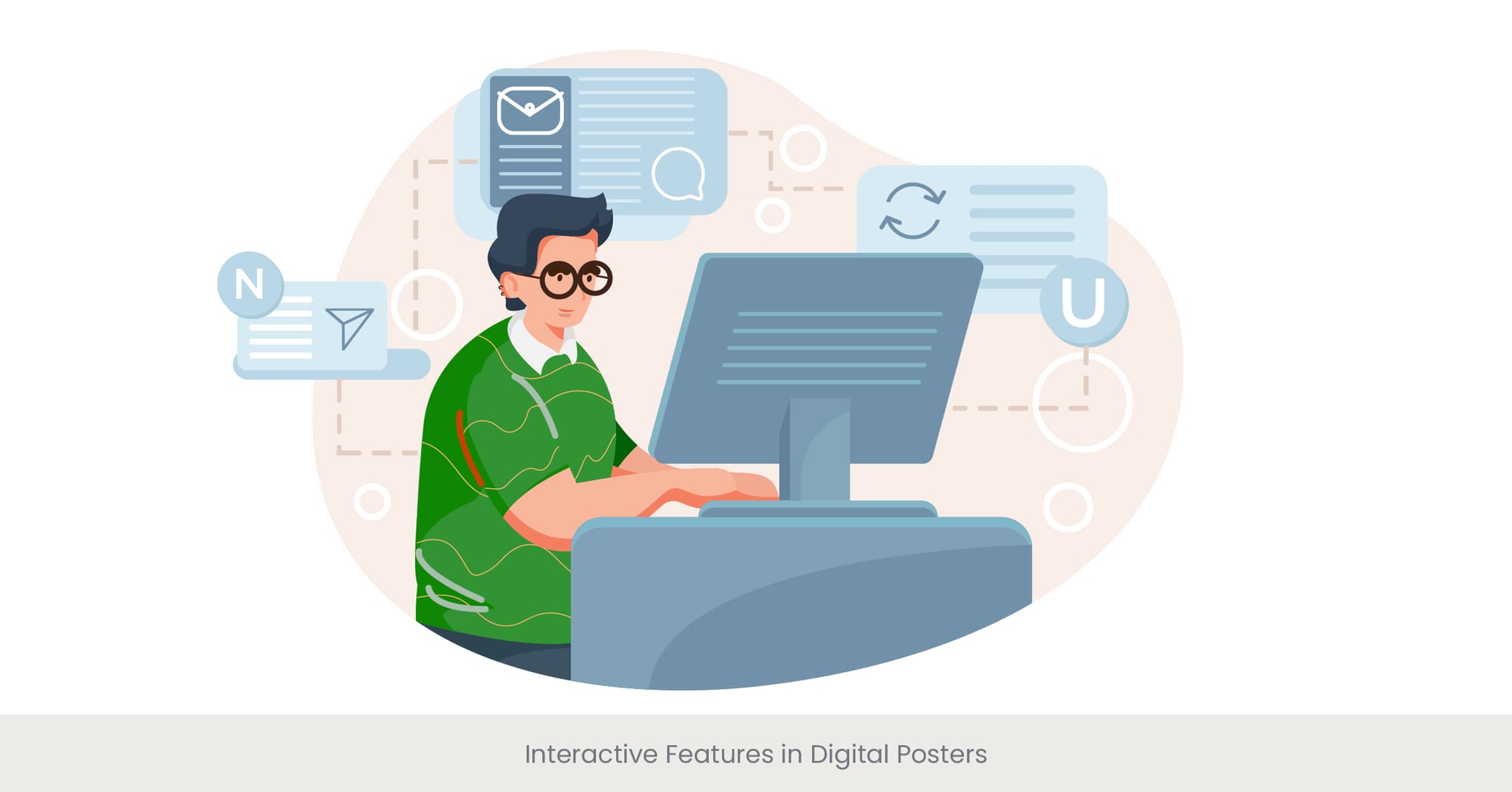
Transitioning from Print to Digital Posters

Shifting Paradigms: Embracing the Digital Revolution in Poster Presentations
As we move deeper into the digital age, the transition from traditional printed posters to digital posters represents a significant evolution in how information is presented and consumed. This shift is not just about changing the medium of display but also transforming the way audiences engage with content. Engaging visuals for posters, leveraging dynamic multimedia capabilities, offer a more interactive and accessible platform for sharing knowledge and information across various fields, from academic research to industry conferences.
Digital posters are not merely electronic versions of traditional printed posters; they represent a new approach to visual communication. With the increasing availability of digital display technologies and software, poster boards and presentations can now incorporate animations, videos, and hyperlinks, making them more engaging than ever. This evolution in poster presentation coaching is driven by the need for more sustainable practices, reducing the environmental impact associated with the production and disposal of printed materials.
Real-world examples of this transition abound in academic and professional conferences where digital posters are becoming the norm. For instance, major scientific conferences have begun to adopt online virtual poster presentations, allowing researchers from around the world to present their findings without the physical constraints of a traditional conference setting. These sessions not only save on resources but also offer greater flexibility for interaction among participants.
The effectiveness of digital scientific posters also has been substantiated by numerous studies. For example, a survey conducted at a recent international science conference revealed that participants found digital poster sessions more engaging and informative compared to traditional poster sessions. They appreciated the ability to access the content asynchronously and revisit complex information through embedded multimedia resources. This feedback underscores the growing importance of digital solutions in enhancing academic and professional exchanges.
Platforms for Creating and Sharing Digital Posters

Expanding Horizons: Tools and Platforms for Innovative Digital Posters
The creation and dissemination of digital posters are supported by a variety of robust platforms designed to accommodate the needs of diverse users, from academics to marketing professionals. These platforms not only simplify the design process but also enhance the reach and impact of poster presentations by facilitating easy sharing and interaction. By utilizing these tools, creators can transform traditional presentations into dynamic digital experiences that captivate and engage audiences.
Key platforms like Canva, Adobe Spark, and Piktochart have revolutionized the way digital posters are designed. These tools provide users with a range of customizable printable poster templates, intuitive design interfaces, and interactive elements, making it possible for anyone, regardless of their graphic design skills, to create professional-looking digital posters. Moreover, these platforms support collaboration, allowing teams to work together remotely and in real-time, which is essential in today’s increasingly digital workspace.
The practical applications of these platforms are vast. For instance, in educational settings, teachers use digital poster-making tools to encourage students to present their research findings creatively. In the business sector, companies utilize these platforms to produce marketing materials that attract and engage potential customers on social media and other digital channels. Each of these examples demonstrates the platforms' versatility and capability to support various presentation goals.
Research and case studies highlight the effectiveness of these platforms in enhancing communication. A recent study published in the "Journal of Digital Media & Policy" examined how digital posters created on these platforms facilitated greater engagement and information retention among viewers compared to traditional formats. Furthermore, metrics from these platforms can provide insights into viewer interactions, such as the number of views, shares, and the time spent on each poster, offering valuable feedback to the creators for future improvements.
Enhancing Your Digital Poster with Multimedia

Elevating Impact: Integrating Multimedia into Digital Posters
The integration of multimedia elements is a transformative step in the evolution of print and digital posters, turning static displays into dynamic and interactive experiences. By embedding audio, video, and animated content, creators can significantly enhance the communicative power of their posters, making complex information more accessible and engaging to a wider audience. This multimedia approach not only captures attention but also facilitates deeper understanding and retention of the presented information.
Historically, the use of multimedia in presentations has shown to improve audience engagement. For example, incorporating video into digital posters can convey processes or results that are difficult to capture with still images or text alone. Similarly, adding audio clips can provide additional explanations or showcase interviews with experts, which enriches the audience's understanding of the topic. Animated infographics and interactive data visualizations further allow viewers to explore datasets in a more engaging way compared to traditional static graphs.
Real-world applications of multimedia-enhanced digital posters are particularly evident in fields like science, education, and marketing. In academic conferences, researchers use video to demonstrate experimental procedures or results, making their posters more informative and appealing to fellow researchers. In classrooms, teachers utilize interactive posters to facilitate active learning and discussion among students. In the marketing realm, companies create animated posters to catch the eye of potential customers on bustling platforms like social media.
Studies and reports underline the effectiveness of multimedia in digital posters. For instance, a survey conducted at a recent tech conference indicated that posters incorporating video and interactive elements received significantly more attention and engagement from attendees compared to traditional digital posters. These multimedia features not only draw viewers in but also provide them with a memorable learning experience, as they are more likely to recall information presented in a dynamic and interactive manner.
Interactive Features in Digital Posters

Interactive Engagement: Revolutionizing Poster Presentations with Interactive Elements
Interactive features in digital posters are redefining the way information is presented and consumed, making it a two-way conversation rather than just a couple one-way dissemination. These features, such as clickable links, embedded questionnaires, and live chat functions, not only enhance the viewer's engagement but also allow for immediate feedback and deeper exploration of the content. The shift towards interactive online virtual poster presentations represents a significant leap forward in educational and professional settings, where audience engagement and interaction are crucial.
The background of interactive technology in educational tools shows that engagement levels are substantially higher when content is interactive. Traditional posters, while informative, often limit the viewer's experience to visual absorption of information. By contrast, interactive digital posters encourage viewers to engage with the content actively, navigating through different layers of information, accessing additional resources, and even participating in real-time discussions.
Real-world examples of interactive digital posters include academic conferences where researchers integrate QR codes and hyperlinks that lead to further reading or detailed datasets. Similarly, in industry trade shows, companies can use interactive elements to demonstrate product features or to collect leads directly through the poster. These applications not only make the poster more functional but also greatly increase the retention of information and viewer satisfaction.
Research supports the efficacy of interactive features in digital presentations. A study from the "International Journal of Digital Media Design" found that presentations incorporating interactive elements could boost audience retention rates by up to 50% compared to non-interactive presentations. Additionally, data collected from these interactions, such as the number of clicks, time spent on each section, and user feedback, can be invaluable for presenters to understand the impact of their work and refine their future presentations.
Measuring Engagement with Digital Posters

Metrics that Matter: Gauging Viewer Engagement in virtual Poster Sessions
In the realm of digital posters, measuring engagement goes beyond merely counting the number of viewers. Advanced metrics such as interaction rates, time spent per session, and viewer feedback are crucial for understanding how effectively a digital poster communicates its message and engages its audience. These metrics not only help in assessing the success of a poster but also provide valuable insights that can be used to enhance future digital presentations.
The significance of measuring engagement is rooted in the digital transformation of communication and presentation. In traditional poster settings, gauging an audience's attention and interest could be challenging beyond observing physical attendance and direct interactions. However, with digital posters, analytics tools can track detailed engagement metrics like the number of views, interactions with interactive elements, duration of engagement, and geographic distribution of the audience. This data is instrumental in understanding the reach and impact of a presentation.
Real-world applications of these metrics can be seen in various sectors. For example, academic institutions often analyze engagement data from virtual poster sessions to identify topics that resonate most with students or to gauge the effectiveness of different teaching methods. In the corporate world, marketing teams utilize engagement metrics to refine strategies for digital advertisements or informational content, ensuring that they capture and maintain the audience's attention effectively.
Several studies underscore the importance of engagement metrics in digital presentations. A notable research paper published in the "Journal of e-Learning and Knowledge Society" highlighted how engagement metrics provided by digital poster platforms helped organizers of a major educational conference to optimize session timings, layouts, and content formats. These adjustments, informed by real data, significantly improved participant satisfaction and interaction rates in subsequent events.
SEO Strategies for Digital Posters

Optimizing Visibility: SEO Techniques for Digital Poster Success
Search Engine Optimization (SEO) is not just for websites and blogs. Implementing SEO strategies for digital posters can dramatically increase their visibility and accessibility online, ensuring that these valuable resources reach a broader audience. By optimizing digital poster design with targeted keywords, meta descriptions, and accessible page design elements, creators can enhance their discoverability on search engines and within digital archives.
The foundation of SEO for digital posters lies in understanding how search engines index and rank content. Traditional SEO techniques such as keyword integration, backlinking, and alt-text for images are equally important for digital posters. For instance, including relevant SEO for digital posters in the title and description, as well as in the content itself, can help the poster show up in specific search queries related to its topic.
The importance of these strategies is highlighted through numerous case studies. For example, academic conferences that optimized their digital poster presentations for search engines reported a significant increase in online engagement and downloads. By implementing simple SEO strategies, they were able to attract attendees from a wider geographical area, thus expanding their audience and impact.
Moreover, leveraging multimedia elements in SEO can enhance the user experience and engagement, which are crucial factors in search engine algorithms. Embedding videos, using high-quality images, and ensuring that interactive elements are mobile-friendly and accessible can all contribute to higher SEO rankings. Additionally, tracking engagement through analytics allows creators to understand which aspects of their digital posters are performing well and which areas might need more optimization.
Studies have shown that well-optimized digital content can outperform traditional content in search rankings, leading to increased visibility and engagement. A review in the "Digital Marketing Journal" noted that posters with optimized titles and descriptions, along with interactive and multimedia elements, performed better in search engine result pages (SERPs), thereby attracting more viewers and interactive engagements.
Accessibility Considerations for Digital Posters

Inclusive Design: Ensuring Accessibility in Digital Poster Presentations
Accessibility in digital posters is crucial to ensure that all potential viewers, regardless of their abilities, can access, understand, and interact with the content effectively. This not only broadens the audience reach but also complies with legal standards and ethical considerations in digital communication. By incorporating accessibility features, poster creators demonstrate a commitment to inclusivity, enhancing the user experience for a diverse audience.
Accessibility considerations begin with the digital poster design process, focusing on color contrasts, font sizes, and the logical organization of information. Text-to-speech compatibility, alternative text for images, and keyboard navigability are essential for users with visual impairments. Moreover, ensuring that multimedia elements have captions or transcripts is vital for hearing-impaired users. These elements help create a barrier-free environment, allowing everyone to engage fully with the digital poster.
Real-world applications of accessible digital posters can be observed in various sectors, from education to healthcare. For instance, universities adopt accessible digital poster templates to accommodate students with disabilities during research presentations, thereby fostering an inclusive academic environment. Similarly, medical conferences use accessible digital posters to ensure that all attendees, including those with disabilities, can access valuable health information and research findings.
The impact of accessible design on engagement and user satisfaction is significant. Research indicates that accessible digital posters achieve higher interaction rates and positive feedback, particularly from communities traditionally underrepresented in digital spaces. A study published in the "Journal of Accessibility and Design" found that conferences incorporating accessibility features in their digital posters reported higher overall attendee satisfaction and increased return participation.
Need Help with Your Digital Poster?
Digital Poster Design Software

Crafting Excellence: Leading Software for Designing Impactful Digital Posters
Choosing the right software is pivotal in creating effective digital posters that not only convey information but also engage and inspire the audience. The landscape of digital poster design software offers a variety of tools that cater to different needs, ranging from simple drag-and-drop interfaces for beginners to advanced features for professional designers. These tools provide the flexibility and creative control necessary to produce high-quality digital posters that stand out in any professional or academic setting.
Software platforms like Adobe Illustrator, Canva, and Venngage stand at the forefront of digital poster design. Adobe Illustrator offers precision and versatility with extensive tools that cater to detailed vector artwork, essential for creating high-resolution posters. Canva simplifies the design process with its user-friendly interface and a vast library of templates that can be easily customized, making it ideal for users without extensive graphic design experience. Venngage specializes in data visualization, offering features that help users transform complex data into engaging infographics, enhancing the informational value of the poster.
These tools are not just about creating visually appealing designs; they also support collaboration and sharing features that facilitate teamwork and quick access to feedback. For instance, multiple users can work on the same project in real-time, provide instant feedback, and even share their designs directly through social media or embedded links on websites. This collaborative approach is particularly beneficial in educational and corporate environments where team projects and feedback loops are common.
The effectiveness of these software tools in enhancing digital poster design is evident in their widespread adoption and positive user reviews. Educational institutions often recommend specific digital poster design software to students to help them create compelling presentations for coursework and research. Similarly, in professional settings, the ability to produce polished, persuasive digital posters can significantly influence audience engagement and message retention.
Read Our Free Guide on Digital Poster Design!
Virtual Conference Posters: Best Practices

Mastering the Virtual Showcase: Effective Strategies for Conference Poster Design
Virtual conference posters are a critical element in the dissemination of knowledge in today’s increasingly digital academic and professional landscapes. These posters need to be designed with both clarity and engagement in mind to effectively convey complex information to an audience that interacts with them in a fundamentally different way compared to traditional in-person poster sessions. Adopting best practices in design and using poster presentation examples can significantly enhance the effectiveness and impact of these virtual posters.
One key practice is the focus on simplicity and readability. Virtual posters should avoid overcrowding with too much text and graphics. Using clear, concise language and visually appealing graphics can help in making complex information more digestible. Ensuring that posters are easily navigable at a glance is essential, as virtual conference attendees often browse many posters in a single session. Employing a logical flow of information, prominent section headings, and a coherent color scheme can guide viewers through the content effectively.
Interactive elements such as hyperlinks, videos, and clickable sections can transform a static poster or talk into a dynamic experience. These features encourage viewers to engage more deeply with the material, exploring additional resources, methodologies, and results that might not be as accessible in a more printed poster format. Furthermore, virtual posters allow for real-time interaction features, like Q&A sessions or live chats, which can facilitate immediate dialogue between the presenter and the audience.
The importance of these best practices is underscored by feedback from recent virtual conferences. Attendees frequently highlight the ease of navigation, the ability to directly interact with content, and the aesthetic appeal of well-designed virtual posters as key factors that enhance their conference experience. Surveys from these events often show a strong preference for sessions that effectively utilize these design principles, indicating their critical role in successful virtual presentations.
Explore Our Case Studies for Design Inspiration!
Future of Digital Poster Presentations

Evolving Trends: The Next Frontier in Digital Poster Technology
The future of digital poster presentations is promising, with ongoing advancements in technology continually reshaping how information is created, displayed, and interacted with. Emerging trends and technologies like augmented reality (AR), virtual reality (VR), and artificial intelligence (AI) are set to further revolutionize the landscape of digital posters. These innovations promise to enhance the immersive experience and interactivity of poster presentations, making them more effective and engaging for audiences across the globe.
Augmented reality and virtual reality, in particular, offer exciting possibilities for digital posters by creating immersive environments where users can interact with three-dimensional data visualizations or simulations. This could be particularly transformative for fields such as science and medicine, where being able to visually explore complex structures or phenomena can greatly enhance understanding and engagement. AI, on the other hand, can be used to personalize content delivery based on viewer interest or prior knowledge, providing a tailored experience that maximizes learning and engagement.
The integration of these technologies into digital posters is not just speculative; pilot projects and early adopters are already demonstrating their potential. For example, at a recent international tech conference, a series of digital posters used AR to allow viewers to see through the mechanics of machinery simply by pointing their smartphones at different parts of the poster. This kind of interactive experience not only makes learning more engaging but also more comprehensive.
Looking ahead, the role of data analytics in digital posters is also set to expand. As digital engagement metrics become more sophisticated, poster creators will have access to real-time feedback on how their posters are being interacted with, allowing them to make immediate adjustments to improve effectiveness. This real-time adaptability will not only enhance the viewer experience but also empower creators to be more responsive to their audience’s needs.
Stay Updated with Our Latest Blogs and Guides!
FAQs on Digital Posters
What is a digital poster?
A digital poster is a digital version of a traditional poster that uses multimedia elements such as images, videos, and interactive content to present information. It is commonly used in academic, professional, and marketing contexts to communicate ideas effectively.
How do I make an online digital poster?
To create an online digital poster, you can use digital design software such as Canva, Adobe Spark, or Piktochart. These platforms offer templates and tools to easily incorporate various multimedia elements and design an engaging a poster online.
Is PowerPoint a digital poster?
PowerPoint can be used to create digital posters by designing a single slide with graphical and textual information. While traditionally used for slide presentations, PowerPoint offers tools that can effectively be adapted for static or interactive poster designs.
Which app is best for digital poster making?
Apps like Canva and Adobe Spark are popular choices for digital poster making due to their user-friendly interfaces, extensive libraries of templates, and robust design features that cater to both beginners and professionals.
What is a technical poster presentation?
A technical poster presentation is a method of presenting technical or scientific background information using a poster format that allows for a concise and attractive visualization of research findings, typically used in academic and professional settings.
What should be included in a poster presentation?
A poster presentation should include a clear title, introduction, methods section, a results section, and conclusions. It should also use visuals such as charts, graphs, and images to support the text and engage the audience.
What makes a good poster presentation?
A good poster presentation is visually appealing, well-organized, and concise. It effectively communicates the main points of a research project or other important information, with supporting visuals and minimal text to engage viewers quickly.
What makes a poster interactive?
A poster becomes interactive by incorporating elements that allow viewers to engage directly with the poster online content, such as QR codes, interactive links, multimedia elements, and live feedback or chat features.
What do you do in a poster session?
In a poster session, presenters display their posters and stand by them to discuss and explain their work with attendees, answer questions, and receive feedback. It allows for informal, in-depth conversations about the research or topics displayed.
How do you organize a virtual poster session then?
To organize a poster session, arrange a venue with adequate space for posters and audience movement, schedule the poster session and times, take poster submissions, provide equipment for displaying posters, and promote the event to attract attendees.
What is a Poster Templates presentation example?
An example of a poster presentation might be a researcher presenting a poster summarizing their work on climate change effects on coral reefs, including graphical data and summaries of their findings.
What is a poster discussion session?
A poster discussion session is a format in academic conferences where multiple posters presenting something are displayed simultaneously, and attendees discuss the content with the presenters in a structured or semi-structured format.
What are the benefits of poster sessions?
Poster sessions offer presenters the opportunity to interact directly with their audience, receive free and immediate feedback, network with peers, and discuss their research in a detailed and personalized manner.



%20(1).jpg)
%20(1).jpg)


